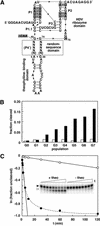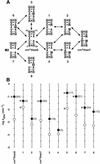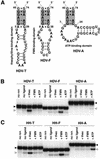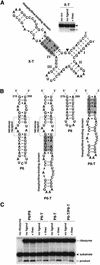A versatile communication module for controlling RNA folding and catalysis
- PMID: 12409449
- PMCID: PMC135812
- DOI: 10.1093/nar/gkf596
A versatile communication module for controlling RNA folding and catalysis
Abstract
To exert control over RNA folding and catalysis, both molecular engineering strategies and in vitro selection techniques have been applied toward the development of allosteric ribozymes whose activities are regulated by the binding of specific effector molecules or ligands. We now describe the isolation and characterization of a new and considerably versatile RNA element that functions as a communication module to render disparate RNA folding domains interdependent. In contrast to some existing communication modules, the novel 9-nt RNA element is demonstrated to function similarly between a variety of catalysts that include the hepatitis delta virus, hammerhead, X motif and Tetrahymena group I ribozymes, and various ligand-binding domains. The data support a mechanistic model of RNA folding in which the element is comprised of both canonical and non-canonical base pairs and an unpaired nucleotide in the active, effector-bound conformation. Aside from enabling effector-controlled RNA function through rational design, the element can be utilized to identify sites in large RNAs that are susceptible to effector regulation.
Figures




Similar articles
-
Altering molecular recognition of RNA aptamers by allosteric selection.J Mol Biol. 2000 May 12;298(4):623-32. doi: 10.1006/jmbi.2000.3704. J Mol Biol. 2000. PMID: 10788325
-
Rational design of allosteric ribozymes.Chem Biol. 1997 Jun;4(6):453-9. doi: 10.1016/s1074-5521(97)90197-6. Chem Biol. 1997. PMID: 9224568
-
Linkage between proton binding and folding in RNA: implications for RNA catalysis.Biochem Soc Trans. 2005 Jun;33(Pt 3):466-70. doi: 10.1042/BST0330466. Biochem Soc Trans. 2005. PMID: 15916542 Review.
-
Ribozymes of the hepatitis delta virus: recent findings on their structure, mechanism of catalysis and possible applications.Acta Biochim Pol. 2001;48(2):409-18. Acta Biochim Pol. 2001. PMID: 11732611 Review.
-
Catalytic strategies of the hepatitis delta virus ribozymes.Annu Rev Biochem. 2002;71:887-917. doi: 10.1146/annurev.biochem.71.110601.135349. Epub 2001 Nov 9. Annu Rev Biochem. 2002. PMID: 12045114 Review.
Cited by
-
Rube Goldberg goes (ribo)nuclear? Molecular switches and sensors made from RNA.RNA. 2003 Apr;9(4):377-83. doi: 10.1261/rna.2200903. RNA. 2003. PMID: 12649489 Free PMC article. Review.
-
Controlling mammalian gene expression by allosteric hepatitis delta virus ribozymes.ACS Synth Biol. 2013 Dec 20;2(12):684-9. doi: 10.1021/sb400037a. Epub 2013 May 22. ACS Synth Biol. 2013. PMID: 23697539 Free PMC article.
-
Cell-free transcription-translation system: a dual read-out assay to characterize riboswitch function.Nucleic Acids Res. 2023 Aug 25;51(15):e82. doi: 10.1093/nar/gkad574. Nucleic Acids Res. 2023. PMID: 37409574 Free PMC article.
-
A modular and extensible RNA-based gene-regulatory platform for engineering cellular function.Proc Natl Acad Sci U S A. 2007 Sep 4;104(36):14283-8. doi: 10.1073/pnas.0703961104. Epub 2007 Aug 20. Proc Natl Acad Sci U S A. 2007. PMID: 17709748 Free PMC article.
-
A general method for rapid and nondenaturing purification of RNAs.RNA. 2004 Jun;10(6):988-95. doi: 10.1261/rna.7040604. RNA. 2004. PMID: 15146082 Free PMC article.
References
-
- Tang J. and Breaker,R.R. (1997) Rational design of allosteric ribozymes. Chem. Biol., 4, 453–459. - PubMed
-
- Kuwabara T., Warashina,M., Tanabe,T., Kenzaburo,T., Asano,S. and Taira,K. (1998) A novel allosterically trans-activated ribozyme, the maxizyme, with exceptional specificity in vitro and in vivo. Mol. Cell, 2, 617–627. - PubMed
-
- Robertson M.P. and Ellington,A.D. (1999) In vitro selection of an allosteric ribozyme that transduces analytes to amplicons. Nat. Biotechnol., 17, 62–66. - PubMed
Publication types
MeSH terms
Substances
LinkOut - more resources
Full Text Sources
Other Literature Sources
Research Materials

